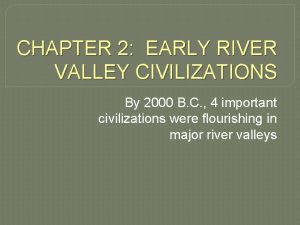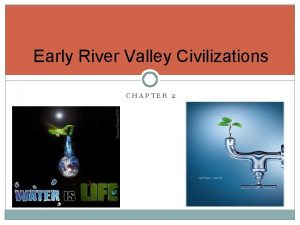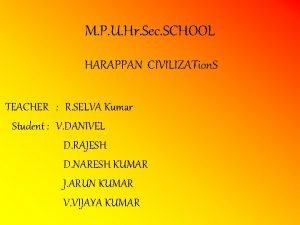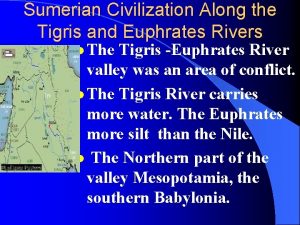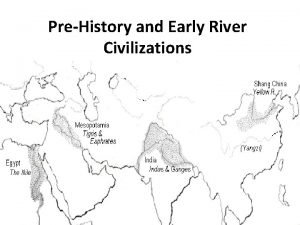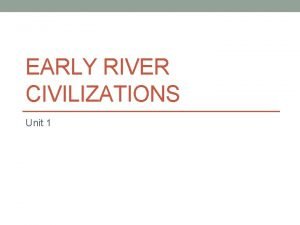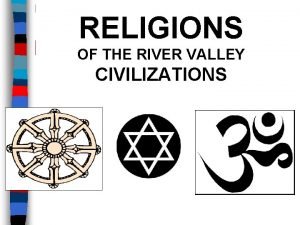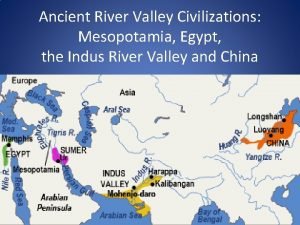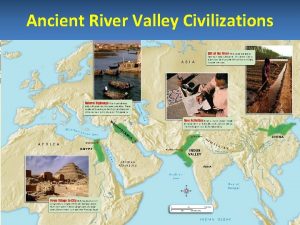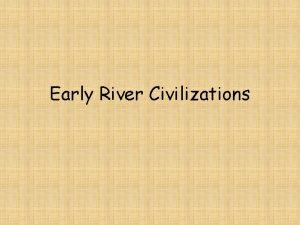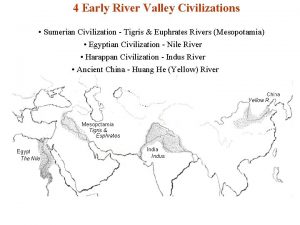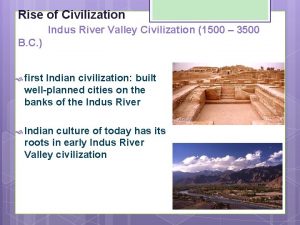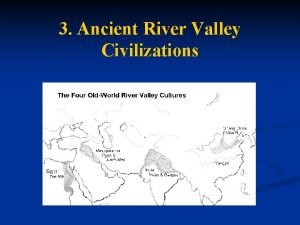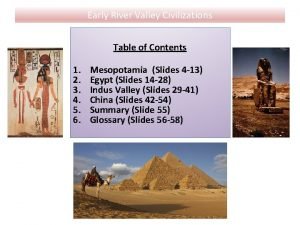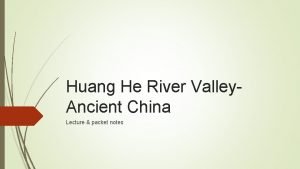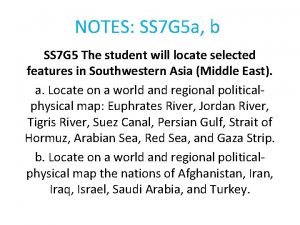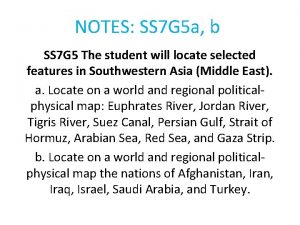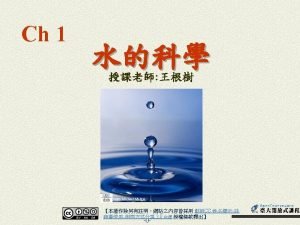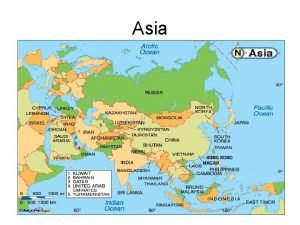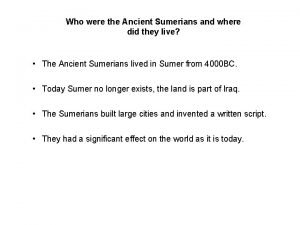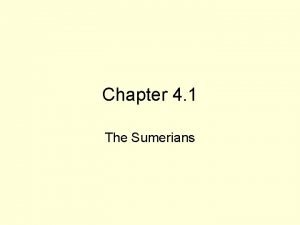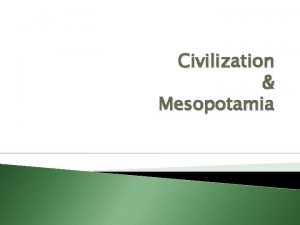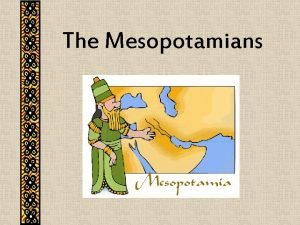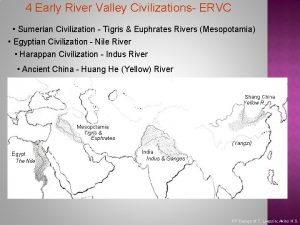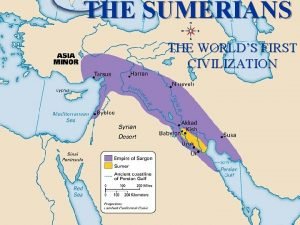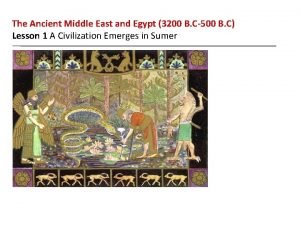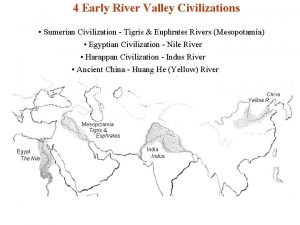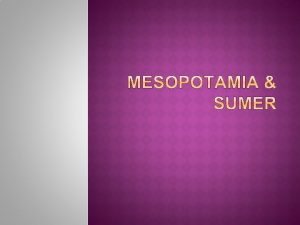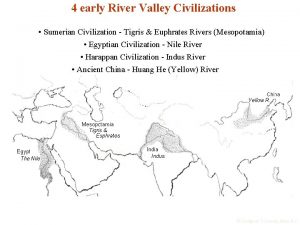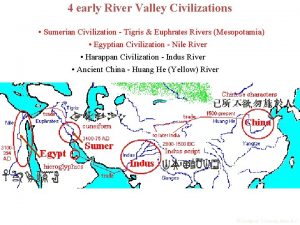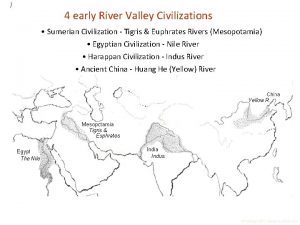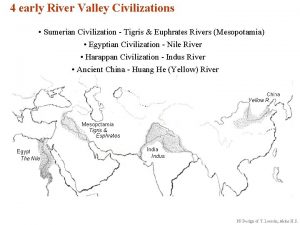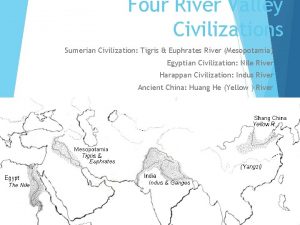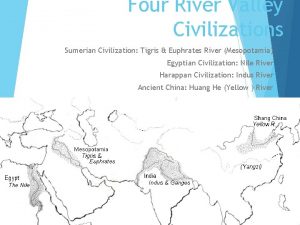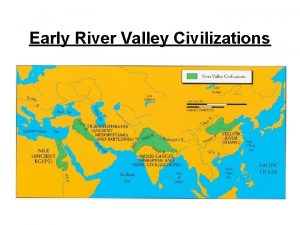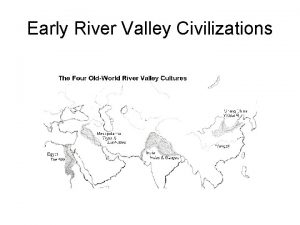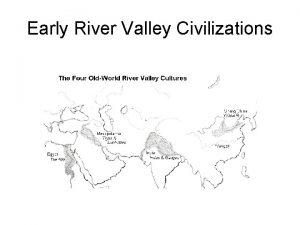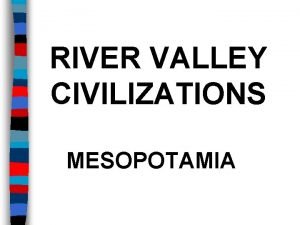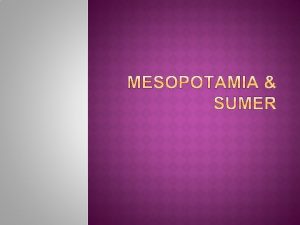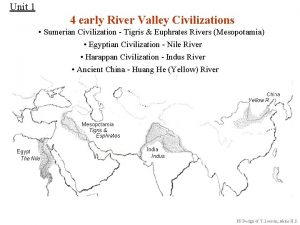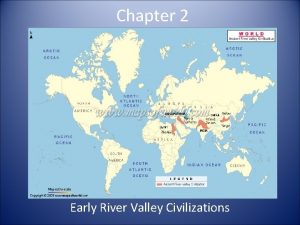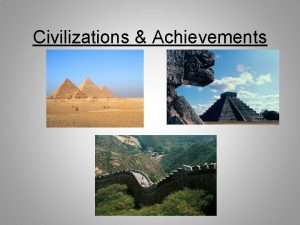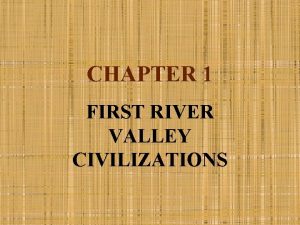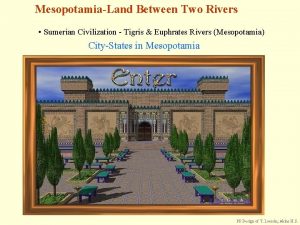4 early River Valley Civilizations Sumerian Civilization Tigris































- Slides: 31

4 early River Valley Civilizations • Sumerian Civilization - Tigris & Euphrates Rivers (Mesopotamia) • Egyptian Civilization - Nile River • Harappan Civilization - Indus River • Ancient China - Huang He (Yellow) River

Are Mesopotamia; Egypt; & the Indus Valley Civilizations really considered civilizations according to the 7 Characteristics? • Get into small groups of 3 -4 students • See if you can provide examples from the River-Valley Civilizations that fit each of the Characteristics • Decide as a group what your answer is to the above question. Characteristic Cities Complex social structure Centralized Gov’t Specialized Jobs Art/Architecture Writing Long-distance Trade Notes

“The Four Early River Valley Civilizations” Tigris & Euphrates Rivers (Mesopotamia) Babylon; Assyria; Sumer PP Design of T. Loessin; Akins H. S.

Chapter 2 Lecture Outline: “The Four Early River Valley Civilizations” City-States in Mesopotamia I. GEOGRAPHY A. Mostly dry desert climate in SW Asia (Middle East) 1. Except in region between Tigris / Euphrates rivers 2. a flat plain known as Mesopotamia lies between the two rivers 3. Because of this region’s shape and the richness of its soil, it is called the Fertile Crescent. SW Asia (the Middle East) Fertile Crescent PP Design of T. Loessin; Akins H. S.

City-States in Mesopotamia II. The City-State Structure of Government A. Although all the cities shared the same culture … B. each city had its own government / rulers, warriors, it’s own patron god, and functioned like an independent country Define type of government C. Powerful priests held much political power in the beginning. D. Military commanders eventually became ruler / monarch Dynasty – a series of rulers descending from a single family line. Define type of government

The Ziggurat at Ur was first excavated by British archaeologist Woolley in 1923. The Iraqi Directorate of Antiquities restored its lower stages in the 1980 s.

Chapter 2 Lecture Outline: “The Four Early River Valley Civilizations” City-States in Mesopotamia III. SUMERIAN CULTURE A. RELIGION 1. Belief in many gods - polytheism God of the clouds / air was Enlil – the most powerful god. 2. Gilgamesh Epic, one of the earliest works of literature. Contains a “flood story” that predates the Hebrew Old Testament story of Noah by at least 2, 000 years. PP Design of T. Loessin; Akins H. S.

Chapter 2 Lecture Outline: “The Four Early River Valley Civilizations” City-States in Mesopotamia III. SUMERIAN CULTURE B. SOCIETY 1. Three social classes a. Priests and royalty (kings) b. Wealthy merchants c. Ordinary workers [Slaves] –were not free citizens and thus not included in class system 2. Women a. Had more rights than in many later civilizations (could own property, join lower ranks of priesthood) b. But not allowed to attend schools (could not read or write) Left: Statue of Sumerian woman with hands clasped at chest, ca. 2600 -2300 B. C. Right: Gypsum statue of man and woman at Inanna Temple at Nippur, circa 2600 -2300 B. C.

Chapter 2 Lecture Outline: “The Four Early River Valley Civilizations” City-States in Mesopotamia III. SUMERIAN CULTURE C. SCIENCE & TECHNOLOGY 1. One of the first writing systems - Cuneiform 2. Invented wheel, the sail, the plow 3. First to use bronze. PP Design of T. Loessin; Akins H. S.

Review Questions 1. Nick name given to the Mesopotamian Region? 2. What type of government system did Mesopotamia have? 3. What is a dynasty? 4. What was the main god of Mesopotamia? 5. Name 2 science/culture/technological advancements of the Mesopotamians?

Chapter 2 Lecture Outline: “The Four Early River Valley Civilizations” I. GEOGRAPHY Egypt on the Nile B. Upper and Lower Egypt 1. Most of Egypt’s history focused around Lower Egypt, around the Nile delta which flows into the Mediterranean Sea. 2. Upper Egypt developed later upstream 3. Nile provided reliable transportation C. Environment 1. Unlike Mesopotamia, the Nile was predictable 2. Deserts on both sides of Nile - provided natural protection against invaders - also reduced interaction with other people

Chapter 2 Lecture Outline: “The Four Early River Valley Civilizations” Egypt on the Nile II. UNITED EGYPT’S GOVERNMENT C. The Pharaoh [means, royal house] – the ruler of Egypt 1. were considered gods; served both political and religious roles Type of government where the political rulers are thought to be divinely-guided, or even divine themselves is a theocracy. The Great Pyramids at Giza. Define type of government

EARLY DYNASTIC PERIOD 2920 -2575 BCE OLD KINGDOM - 2660 -2180 BCE MIDDLE KINGDOM 2180 -1550 BCE ----------------------------------------NEW KINGDOM 1550 -1070 BCE (CH 4 Coverage) ------------------------------------------------------------------------------------------------------------------------------------ PP Design of T. Loessin; Akins H. S.

Chapter 2 Lecture Outline: “The Four Early River Valley Civilizations” Egypt on the Nile III. EGYPTIAN CULTURE A. RELIGION 1. Polytheistic a. Over 2, 000 Ra, Sun god; Horus, sky god; Isis, goddess of fertility (associated with Nile – mother “giver of life”) b. Belief in afterlife! c Mummification The Funerary Scene This scene depicts what occurs after a person has died, according to the ancient Egyptians. The Egyptians had an elaborate and complex belief in the afterlife. PP Design of T. Loessin; Akins H. S.

Chapter 2 Lecture Outline: “The Four Early River Valley Civilizations” Egypt on the Nile III. EGYPTIAN CULTURE B. SOCIETY STRUCTURE • Royal Family • Upper class Landowners (also known as aristocracy or nobility) Priests Army commanders Government officials • Middle Class (merchants / artisans) • Lower class (peasant farmers, unskilled laborers 2. Women had many of the Socially Mobile classes same rights as men, Not “locked in”, could own property, lower and middle classes could seek divorce. could rise up through marriage or through merit (success). Later we’ll discover a couple of women who actually ruled Egypt! Did you know… Men and women wore makeup in Egypt. The dark-lined eyes that look out at us from the artwork of ancient Egypt was the height of fashion and was called kohl – powdered minerals mixed with water and applied with a small stick. Both genders also wore lipstick – crushed red ocher (iron oxide) mixed with oil. Read text p. 37 for more cool info. about Egyptian cosmetics.

Chapter 2 Lecture Outline: “The Four Early River Valley Civilizations” Egypt on the Nile IV. EGYPTIAN WRITING A. Pictographs developed into hieroglyphics B. Written on Papyrus, unfurled reed from the Nile, dried into strips C. Deciphering hieroglyphics The Rosetta Stone, discovered in 1799 A. D. PP Design of T. Loessin; Akins H. S.

The Indus Valley civilization flourished around 2, 500 B. C. in the western part of South Asia, in what today is Pakistan and western India. It is often referred to as Harappan Civilization after its first discovered city, Harappa. The nearby city of Mohenjo. Daro is the largest and most familiar archaeological dig in this region. The Indus Valley was home to the largest of the four ancient urban civilizations of Egypt, Mesopotamia, India and China. This ancient civilization was not discovered until the 1920's. Most of its ruins, including major cities, remain to be excavated. Left: The excavated ruins of Mohenjo-daro. PP Design of T. Loessin; Akins H. S.

Did you know? Hinduism is considered to be the world’s oldest religion. • Began farming along Indus about 3, 200 B. C. • Size of settled region larger than Egypt or Mesopotamia. Yet it’s origins have • Careful city planners; laid out in grid long been a mystery. Indus Harappan script has not been with a defendable citadel. deciphered. Typical Harappan dwellling • Engineered sophisticated plumbing and sewage systems. This means basic questions about Above: Terracota household statues such • Peaceful people – few weapons found the people who created this highly as this female goddess are found • Similarity in housing indicates little differences complex culture frequently in the region. Is this religious between social classes. are still unanswered. icon an early Shiva? Does modern • Religious objects and symbols clearly linked to Hinduism have its origins in Harappan Left: The excavated ruins of Mohenjodaro – one of several planned cities laid out on a grid system in the Indus region. Right: The citadel at Mohenjodaro. civilization?

Chinese script is unique, isn’t it? Think about other elements of Chinese culture: Chinese architecture, music, technology, dress and fashion, and eastern belief systems… Gobi Desert Also unique! Taklimakan Desert Himalaya Mts. Pacific Ocean • China’s geography ocean, desert, high mountains, isolated China. Isolated geographically, cut off from trade, there would be little opportunity for cultural diffusion in China’s case. Developing in a vacuum, China’s civilization would stand out as the most unique of our world’s early civilizations. PEACE LOVE TOLERANCE LUCK ETERNITY

2. What were three features of Shang culture? • First written records - calligraphy writing and paper making • Sharp division between king’s nobles and the peasants • Wood used as building material (not mud-dried bricks as in other regions) • Peasants used wooden tools • Shang made magnificent bronze weapons and ceremonial vessels Pics: Bronze work of the Shang period (1700 -1027 B. C. ). A toilet, an ax, and a cooking cauldron. PP Design of T. Loessin; Akins H. S.

3. Name three important values of Shang culture. • From very early on, the idea of the “group” / community more important than the idea of “individual”/ or any single person. • Emphasis on family, respect of parents • Family emphasized in religion too – ancestor worship. • Oracle bones used to consult the gods • Chinese writing unique to others. Symbols stood for ideas, not sounds. This allowed the many different groups who spoke different languages to all understand the same writing system. Oracle bone PP Design of T. Loessin; Akins H. S.

While the Zhou did simply adopt much of old Shang culture, they also did introduce new things: Above: Jade disk, China’s Zhou period. Below: Bronze helmet and sword, Zhou period. • A new idea of royalty that claimed rulers got their authority from heaven. This was known as the Mandate from Heaven. From this time on the Chinese would believe in divine rule. This meant disasters could be blamed on the rulers and they would frequently be replaced. This led to a pattern of rise and fall of dynasties in China known as the dynastic cycle. • The Zhou gave large regions of land privileges to a select few nobles who then owed loyalty to the king in return. This type of political system the Zhou introduced is called feudalism. • Zhou introduced the first coined money; improved transportation with roads and canals; improved the efficiency of government with trained workers called civil servants; and introduced the first iron-making. PP Design of T. Loessin; Akins H. S.

The Olmec and the Chavín Civilizations

Location of the Olmec: • Mesoamerica – Mexico – Northern Central America • Present-day states Veracruz and Tabasco in Mexico • Pacific coast of Central America and Central Plateau of Mexico

Location: • Andean region of South America • Off northwest coast of South America to Pacific Ocean – Eastern range of Andes – North of present-day Lima, Peru

• Olmec Civilizations – 1200 -400 B. C. E. – Agriculture Based • Corn • Beans • Squash – Fishing civilization – Religious and Political elites emerge • Organized people to: – Dig irrigation systems – Raise fields in wetlands – Construct large scale religious and civic buildings

• Andean Region – – Earliest urban centers 2600 B. C. E. 100 person villages near the coast Great trading took place Chavín • 900 -250 B. C. E. • Agriculture and Domestication – Maize – Potatoes – Llamas • Roads, bridges, temples, palaces, and irrigation systems

Religion • For both Chavín and Olmec – Jaguar-man was their God – It is believed traveling religious missionaries brought this gospel with them as they traveled up and down the coast preaching. • The men of religious authority became leaders • The kings and rulers were the political force

Resources and Architecture • Both the Chavín and Olmec grew because of agriculture • Architecture – Large complexes of multilevel platforms made of packed earth or rubble and cut stone or adobe were found in Chavín. – Olmecs buildings were not quite as complex, but it had the same general idea that the elite were houses on higher up buildings. – These buildings were used to house elites and religious purposes – All the buildings were decorated with serpents, condors, and jaguars.

Olmec • Accomplishments: 1. Written language – bar and dot system 2. Pyramids 3. Olmec Ball game 4. First to use rubber 5. http: //mikeschepker. c om/scholar/Maya. pdf

Chavin accomplishments • • Drainage system Art work out of gold Elaborate temples Domestication of Ilama (Jerky)
 River valley civilizations def
River valley civilizations def Chapter 2 early river valley civilizations
Chapter 2 early river valley civilizations Education of indus valley civilization
Education of indus valley civilization River in sumerian
River in sumerian River valley civilizations map
River valley civilizations map Ancient river valleys map
Ancient river valleys map Which cultures believe in reincarnation
Which cultures believe in reincarnation River valley civilizations vocabulary
River valley civilizations vocabulary 4 river valley civilizations
4 river valley civilizations Ancient river valley civilizations powerpoint
Ancient river valley civilizations powerpoint Tigris euphrates and nile river
Tigris euphrates and nile river Indus river valley job specialization
Indus river valley job specialization 4 river valley civilizations
4 river valley civilizations Indus river valley timeline
Indus river valley timeline Map of river valley civilizations
Map of river valley civilizations Ancient chinese civilization
Ancient chinese civilization Indus river valley civilization cloze reading
Indus river valley civilization cloze reading Ancient china packet
Ancient china packet Tigris and euphrates river
Tigris and euphrates river Tigris river location
Tigris river location Wheres the yellow river
Wheres the yellow river Jordan river southwest asia map
Jordan river southwest asia map Tigris river
Tigris river Tigris and euphrates river
Tigris and euphrates river Where were the sumerians
Where were the sumerians Contribution of sumerian civilization
Contribution of sumerian civilization Sumerian civilization
Sumerian civilization Where were the sumerians
Where were the sumerians Sumerian civilization
Sumerian civilization Ancient sumerians
Ancient sumerians Sumerian civilization
Sumerian civilization Sumerian civilization
Sumerian civilization
